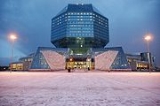
The National Library of Belarus
Encyclopedia
The National Library of Belarus , founded on 15 September 1922, is a copyright library of the Republic of Belarus. It houses the largest collection of Belarusian printed materials and the third largest collection of books in Russian behind the Russian State Library
(Moscow) and the Russian National Library
(St Petersburg).
It is now located in a new 72-metre (236 feet) high building in Minsk
, Belarus
. The building has 22 floors and was completed in January 2006. The building can seat about 2,000 readers and features a 500-seat conference hall. Its main architectural component has the shape of a rhombicuboctahedron
. The library's new building was designed by architects Mihail Vinogradov and Viktor Kramarenko and opened on 16 June 2006.
The National Library of Belarus is the main information and cultural centre of the country. Its depository collections include 8 million items of various media. In 1993 the National Library of Belarus started to create its own electronic information resources. It has generated a collection of bibliographic, factual graphic, full-text, graphic, sound and language databases that comprise more than 2 million records. The scope of databases is quite wide: humanities, social sciences, history, art and culture of Belarus. Library users also have access to databases of other libraries and academic institutions, including foreign ones.
The library service is in great demand. More than 90 thousand citizens of Belarus are library users, who annually request 3.5 million documents. Every day the library is visited by more than 2,200 people. The library delivers about 12,000 documents daily.
In addition to serving as a functional library, the National Library is a city attraction. It is situated in a park on a river bank and has an observation deck looking over Minsk. As of 2009 it is the only structure in Minsk with a public observation deck. The area in front of the library is used for many public concerts and shows.
The building is also the subject of an art video by French artist Raphael Zarka, "Rhombus Sectus", shown at the Bischoff/Weiss gallery, London, in 2011.
Russian State Library
The Russian State Library is the national library of Russia, located in Moscow. It is the largest in the country and the third largest in the world for its collection of books . It was named the V. I...
(Moscow) and the Russian National Library
Russian National Library
The National Library of Russia in St Petersburg, known as the State Public Saltykov-Shchedrin Library from 1932 to 1992 , is the oldest public library in Russia...
(St Petersburg).
It is now located in a new 72-metre (236 feet) high building in Minsk
Minsk
- Ecological situation :The ecological situation is monitored by Republican Center of Radioactive and Environmental Control .During 2003–2008 the overall weight of contaminants increased from 186,000 to 247,400 tons. The change of gas as industrial fuel to mazut for financial reasons has worsened...
, Belarus
Belarus
Belarus , officially the Republic of Belarus, is a landlocked country in Eastern Europe, bordered clockwise by Russia to the northeast, Ukraine to the south, Poland to the west, and Lithuania and Latvia to the northwest. Its capital is Minsk; other major cities include Brest, Grodno , Gomel ,...
. The building has 22 floors and was completed in January 2006. The building can seat about 2,000 readers and features a 500-seat conference hall. Its main architectural component has the shape of a rhombicuboctahedron
Rhombicuboctahedron
In geometry, the rhombicuboctahedron, or small rhombicuboctahedron, is an Archimedean solid with eight triangular and eighteen square faces. There are 24 identical vertices, with one triangle and three squares meeting at each. Note that six of the squares only share vertices with the triangles...
. The library's new building was designed by architects Mihail Vinogradov and Viktor Kramarenko and opened on 16 June 2006.
The National Library of Belarus is the main information and cultural centre of the country. Its depository collections include 8 million items of various media. In 1993 the National Library of Belarus started to create its own electronic information resources. It has generated a collection of bibliographic, factual graphic, full-text, graphic, sound and language databases that comprise more than 2 million records. The scope of databases is quite wide: humanities, social sciences, history, art and culture of Belarus. Library users also have access to databases of other libraries and academic institutions, including foreign ones.
The library service is in great demand. More than 90 thousand citizens of Belarus are library users, who annually request 3.5 million documents. Every day the library is visited by more than 2,200 people. The library delivers about 12,000 documents daily.
In addition to serving as a functional library, the National Library is a city attraction. It is situated in a park on a river bank and has an observation deck looking over Minsk. As of 2009 it is the only structure in Minsk with a public observation deck. The area in front of the library is used for many public concerts and shows.
The building is also the subject of an art video by French artist Raphael Zarka, "Rhombus Sectus", shown at the Bischoff/Weiss gallery, London, in 2011.

